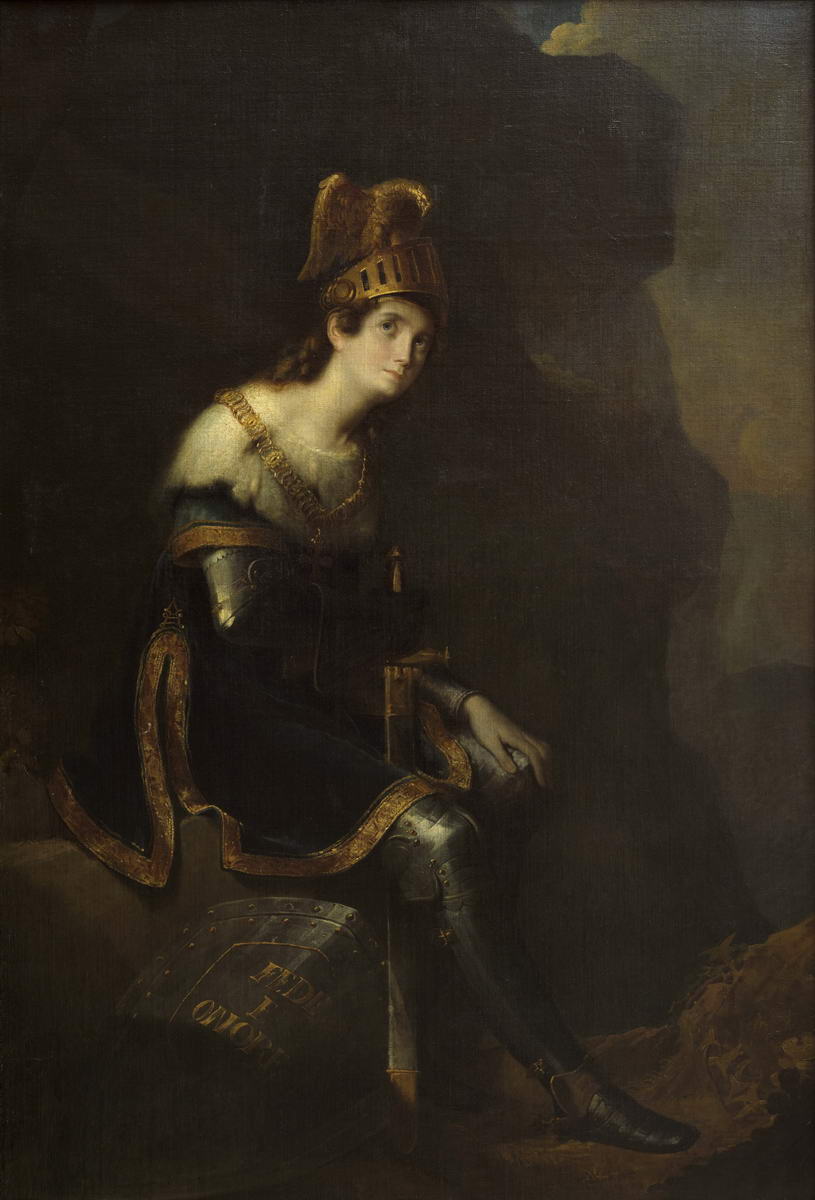


Зинаида Александровна Волконская, урожденная княжна Белосельская-Белозерская (1789—1862) — жена егермейстера, князя Н. Г. Волконского, писательница и музыкант, член Общества любителей словесности и Общества любителей истории и древностей. С 1824 года жила в Москве; в ее доме собирались известные ученые и литераторы. В 1829 году переехала в Рим, где перешла в католичество и после смерти была причислена к лику блаженных (beata). Литографированный портрет 3. А. Волконской в виде Жанны Д'Арк, представляющий собой вариант картины Русского музея, княгиня послала в 1826 А. С. Пушкину с указанием, что о выполнен «с Бруни» (d'apres Bruni).
Портрет З. А. Волконской нельзя отнести к типу парадных изображений в узком значении слова. В работе Бруни нет обязательной для этого жанра репрезентативности. Очевиден романтический характер образа: такого его восприятия требуют полуфантастический костюм, латы и шлем, дикий ландшафт со скалами, оттенок созерцательного одиночества и тоски. Волконская изображена не позирующей, а как будто мечтающей, погруженной в собственные мысли. Состояние модели поддерживается изысканным колоритом: все цвета словно бы мерцают, вспыхивают и уходят в полумрак. На ней костюм Танкреда, главного героя одноименной оперы Д. Россини, которая ставилась в салоне княгини в Риме. Образ, сочетающий героику и веру, любовь и готовность к подвигу, томление и решительность, рожден фантазией Торквато Тассо.
Живописец.
Академик Императорской Академии художеств (с 1834). Почетный член Болонской и Миланской академий искусств, почетный профессор Флорентийской Академии художеств и Академии Св. Луки в Риме. Родился в Милане в семье художника-декоратора А. Бруни. В 1807 приехал с отцом в Россию. Учился в Академии художеств у А. Е. Егорова, А. И. Иванова и В. К. Шебуева (1809-1818). Начиная с 1819 подолгу жил и работал в Италии. С 1836 преподавал в Академии художеств, профессор, с 1855 по 1871 - ректор, с 1866 заведовал мозаичным отделением. Почти все крупные полотна завершил и впервые выставил в Италии. Один из создателей росписей кафедрального Исаакиевского собора в Петербурге и Храма Христа Спасителя в Москве. С 1849 по 1864 - хранитель живописного отдела Эрмитажа, много сделал для пополнения коллекций. Один из наиболее значительных представителей русской академической школы, автор полотен на исторические и библейские темы, портретов. Автор альбома "Русская история в гравюрах", многочисленных эскизов икон и стенных росписей.

Zinaida Alexandrovna Volkonskaya, née princess Beloselskaya-Belozerskaya (1789–1862), Wife of the Master of the Hunt Prince Nikita Volkonsky — writer, musician, member of the Society of Lovers of Literature and the Society of Lovers of History and Antiquities. Since 1824 lived in Moscow; her house was a meeting place for famous scientists and writers. In 1829 she moved to Rome, where she converted to Catholicism and after her death was beatified (beata). A lithographic portrait of Z. A. Volkonskaya as Joan of Arc (the variant of the painting from the Russian Museum collection) was sent by the princess to A. S. Pushkin in 1826, indicating that it was made d'après Bruni (after Bruni). It got to the State Russian Museum in 1926 from the office of the Department of Preservation and Registration of Objects of Art and Antiquities (Leningrad).
In the portrait of Z. A. Volkonskaya is personified the image of a knight from the poem "Jerusalem Delivered" (1575) by the famous Italian poet of the 16th century Torquato Tasso, which combines heroism and faith, love and disposition to heroic deeds, longing and determination. There is no representationalism required for ceremonial portraits. Romantic nature of a theatricalized character is obvious: half-fantastic costume, armour and helmet, wild rocky landscape, a shade of contemplative loneliness and longing. Volkonskaya is depicted as if dreaming, immersed in her own thoughts. The state of the model is maintained by exquisite colour: all the colours seem to twinkle, flash and retreat into the shade. She wears the costume of Tancred, the main character of the eponymous opera by G. Rossini, which was staged in the princess’s salon in Rome.
Painter, engraver, author of religious and history compositions, portraitist. Son of the painter and sculptor Antonio Baroffi-Bruni. Moved to Russia with his father (1807). Studied under Alexei Yegorov, Andrei Ivanov and Vasily Shebuyev at the Imperial Academy of Arts (from 1809). Graduated with a first-class degree (1818). Moved to Rome to con¬tinue his art education (1819). Returned to Russia and painted portraits and icons for churches and cathedrals in St Petersburg and environs (1835-38). Lived and worked in Rome (1838-43, 1843-45). Honorary member of the Academies of Art of Bologna and Milan, professor of the Florentine Academy of Arts and St Luke''s Academy in Rome. Taught at the Imperial Academy of Arts (1836-38, 1846-71). Second-class professor (1836), first-class professor (1846), rector of painting and sculpture (1855-71). Curator of the Imperial Hermitage picture gallery (1849-64), headed the mosaic studio at the Imperial Academy of Arts (from 1866



